Overview
Bamboo is a member of the grass family Poaceae, with species that vary in height from 6 inches to 120 feet.The plants’ woody stems, known as culms, is usually hollow and divided into sections, or internodes, by visible joints or nodes. The upper nodes grow buds, which develop into leaves and branches. There are two types of bamboo: clumping, compact growth close to the plant’s base, and running growth, growth that spreads from its rhizomes.
Bamboo is among the primary signature plant of Asian inspired garden. It is also equally at home in tropical island design themes. In the landscape it can be used as a clump of vertical poles for a columnar element. It has long been choice for creating fast growing barriers, screens and privacy hedges between properties.
Bamboo is grown in various USDA plant hardiness zones depending on the species. As long as you choose the right one and provide your bamboo plant with plenty of water and fertilizer, you can enjoy this exotic, eye-catching plant as much as someone living in a warm and sunny climate.
Culms from bamboos are generally used for scaffolding, boat masts, rural housing, water pipes, vases, buckets, water pitchers, matting, boards and parquet, furniture, water pots. Culm sheaths are used to make hats.
Categories Of Bamboo
Choosing the right bamboo for the right location or the right situation can be tricky with so many different varieties to choose from. Therefore it is important to note that, Bamboos are generally classified into two broad classes: Running and Clumping.
When looking for a bamboo for your new evergreen hedge, identify the height of the hedge you want to grow. Some bamboo plants are dwarfs, growing no more than a few feet high, while others will grow 20 to 30 feet tall. Bamboo varieties are either clumping or running. Many cold hardy varieties are running, but in mild Mediterranean climates, clumping varieties are a better bet. Running varieties, especially in warm climates, can take over in a hurry. Clumping bamboo spreads more slowly and is easier to control.
Difference Between Clumping And Running Bamboo Varieties
Clumping bamboo spreads gradually, slowly forming larger and larger clumps. Running bamboo spreads fast. Before you know it, you’ll have bamboo poking up all over the garden and on the other side of the neighbor’s fence. In warm climates, it is particularly important to pick a clumping variety as running types can be highly invasive. There are ways to control running bamboo, like planting in 30-inch deep trenches lined with heavy plastic or other material, or planting in sunken planters, but even with all the right precautions, running bamboo has a tendency to get away.
Clumping and Running bamboo also differ in their rhizome system. Clumping bamboo has a pachymorph rhizome system, which appears short and thick. These rhizomes curve upward and remain close to the main plant. Removal and transplant of clumping bamboo is difficult, because the rhizomes are compact near the plant’s base. Running bamboo has a leptomorph rhizome system, whose rhizomes branch away from the main plant and appear long and thin. The running bamboo varieties can become invasive and are also difficult to remove once well established.
Types/Varieties Of Bamboo Plants
1. Buddha Bamboo

Buddha’s Belly bamboo (Bambusa ventricosa) is a large cane, non-invasive bamboo that gets its name from the swelling that occurs above and below the cane nodes. The species is native to Vietnam and to Guangdong province in southern China and commonly used in bonsai.
Leaves are simple, linear, 5 to 7 inches long and dark green. The leaves are attached in groups whereas the culms or stems are dark green, tall, arching and often branched. Flowers are typical grass flowers, held in compressed spikelets at the nodes. The fruit is a grain. Though it is a clumping bamboo, it does spread and form dense, tall thickets when planted unencumbered. Best use is in containers or planted with the pot or other restraining method around the roots.
2. Giant Panda Bamboo
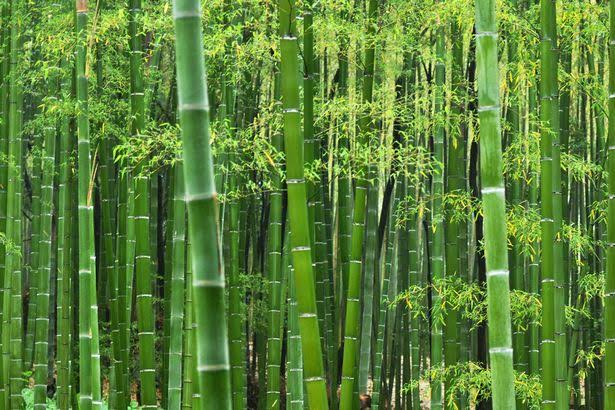
Dendrocalamus giganteus also known as Giant Bamboo or Dragon Bamboo is a giant tropical and subtropical clumping species native to Myanmar (Burma), Bhutan, China and Thailand. It is considered the tallest of all bamboo in the world.
Giant bamboo is consists of gigantic large culms between 25-35 m tall and 15-30 cm in diameter. Culms are thick-walled (2-2.5 cm), dull green to dark bluish green and covered with a white waxy crust when young. Internodes are usually 35-45 cm long, and with roost scars on the lower nodes. Giant Bamboo occurs naturally in humid tropical highlands or hill slopes, usually up to 1,200 m altitude. It can be grown successfully in lowlands on rich loam or alluvial soils, where humidity is high.
3. Black Bamboo (Phyllostachys nigra)

Phyllostachys nigra, commonly referred to as black bamboo, is famous for its ebony-colored stalks, or culms. It is a running bamboo, which means it spreads and grows rapidly through underground rhizomes. Black bamboo is perfect for creating dense walls or natural privacy fences and noise barriers.
Black bamboo culms first appear green before transitioning to their famous black coloring during the second or third year of growth. These culms support bright green, long, lance-shaped leaves, providing a striking contrast against their black color.
This variety of bamboo can grow up to 30 feet high with each culm growing up to two inches thick. It is one of the hardier bamboo species and can be grown in colder climates than most other types of bamboo. Even northern gardeners can enjoy this tropical plant by taking it indoors for the winter.
Also Read: Types of Palm Trees
4. Chinese Fountain Bamboo (Fargesia nitida)

Fargesia are compact, densely clump-forming evergreen bamboos with slender arching canes and several small branches at each node bearing copious narrow leaves, that gives fantastic, graceful appearance. Fargesia nitida (Chinese fountain bamboo) will reach a height of 4m and a spread of 2.5m after 10-20 years. Canes start of green and turn a deep purple as the plant matures. It has a vertical visual pattern with dainty, glaucous evergreen leaves, making it perfect for using as an informal hedge in a partially shaded position.
Chinese fountain bamboo is tough and hardy, able to withstand severe winters. It is also one of the best bamboos for growing in shade. This variety of bamboo is a good choice for hedges and screens, city gardens, along ponds and streams and containers.
5. Slender weavers

Bambusa textilis, also known as slender bamboo or weaver’s bamboo, is an evergreen densely leaved, upright bamboo native to China. This species of bamboo grows in a tight clump up to 6 to 10 meters high and 2 meters in width at a fast rate and has a stem size of 3cm. Its leaves are long and lanceolate shaped. It also has greenish blue-hued culm that is glossy and leathery, its long green internodes, 35-60 cm, and change to yellow during prolonged sunlight exposure.
The stalk and the rhizome are one, making it a non-invasive plant. The top part of the short rhizome has buds, one of which grows into another very truncated rhizome that then turns upward to surface from the ground as a subsidiary culm close to the parent.
Bamboo textilis’ upright growth habit makes the bamboo useful for planting as a privacy screen, windbreak or hedge. Because the variety clumps together tightly and expands slowly, it is effective in small areas. Growth of the roots and the size of the plant is contained when Bambusa textilis is planted near a roadway or concrete sidewalk. Because the plant is tall, it isn’t appropriate for planting near power lines.
Also Read: Types of Jasmine Plant
6. China Gold Bamboo
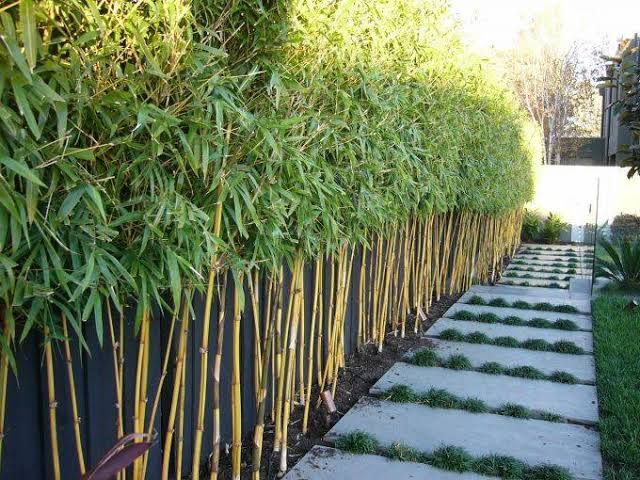
China Gold is a large ornamental bamboo featuring green and gold striped culms and bushy dark green foliage. China Gold will naturally grow up to 6-8 metres in height and can be easily trimmed down in height if need be. This is one of the only ‘large’ bamboo species that can be maintained into very narrow garden beds or pots & troughs!
It has naturally upright culms with wide bushy green foliage like a pom pom on top. It is not a narrow bamboo in terms of foliage. The natural footprint size of the clump is 2mtrs however this wonderful species can be planted into narrow garden beds or maintained smaller to suit your needs, down to a minimum of 40cm, with a root barrier, or 75cm with maintaining the base. It is the only large colourful bamboo that would perform in this area. Plant this variety as a single feature or dense screening solution.
China Gold is extremely quick growing and can be almost fully grown within 18-24 months, and reaching full size in 3 years. Or achieve quicker growth if you purchase more established sizes! China Gold is low maintenance & extremely drought tolerant once established.
7. Japanese Arrow Bamboo
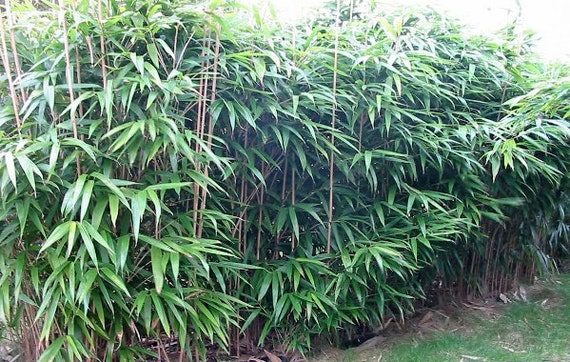
Pseudosasa japonica, the arrow bamboo or metake, is an extremely robust and vigorous bamboo species of flowering plant, native to Japan and Korea. This vigorous bamboo forms thickets up to 6 m (20 ft) tall with shiny leaves up to 25 cm (9.8 in) long. The culms are typically yellow-brown and it has palm-like leaves.
The bamboo can also be grown in pots and makes a good screen or hedge in a controlled environment. Pseudosasa japonica as an extremely robust and vigorous bamboo produces arching canes of large, heavy, glossy, deep-green leaves that lend a lush, jungly and exotic air to their surroundings.
Also Read: Different Types of Fern Plant
8. River Cane Bamboo

Arundinaria gigantea is a species of bamboo known as giant cane or river cane. It is native and endemic to the south-central and southeastern United States. This bamboo, which is a species of cane, is a perennial grass with a rounded, hollow stem which can exceed 7 cm (2.8 in) in diameter and grow to a height of 10 m (33 ft). It grows from a large network of thick rhizomes.
Its lance-shaped leaves are up to 12 inches long and 1.6 inches wide. The inflorescence is a raceme or panicle of spikelets measuring 1.6 to 2.8 inches in length. An individual cane has a lifespan of about 10 years. Most reproduction is vegetative as the bamboo sprouts new stems from its rhizome. It rarely produces seeds and it flowers irregularly. Sometimes it flowers gregariously. Some types of non-native bamboos are confused with this native cane.
9. Multiplex Hedge Bamboo
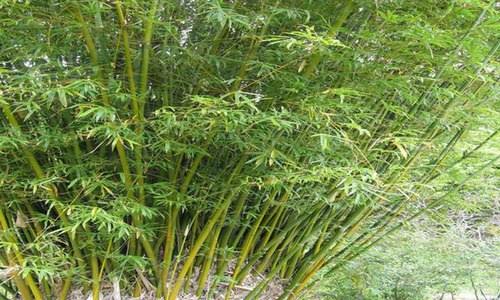
On its original name Bambusa Multiplex, this species is a superior hedge bamboo with deep green color and pencil thin culms. This species is resistant to cold and is a low maintenance variety. One interesting aspect is that when a culm is cut, it stops from growing any taller, and the leaves branch out wider instead.
Originating from China, Multiplex Hedge Bamboo grows very fast and dense. It is cultivated in particular to constitute hedges or privacy screens in suburban yards and can be planted in subtropical/tropical gardens where it can complement the native rainforest flora, and as well as in garden beds near a fence. It can also provide both noise and wind break, in addition to tolerating winds and temperatures as low as -10°C.
10. Dwarf Green Stripe Bamboo

Green stripe bamboo plant (Pleioblastus viridistriatus) is known for its large, showy, and variegated leaves. Striped with contrasting bright green and bright yellow on each of the leaves, this bamboo is perfect as an ornamental grass that can be used for borders almost anywhere in your garden. We love the way the large leaf size contrasts with the tiny stem of which they grow, giving it the true bamboo look, very unique in any garden. It is easy to grow, hardy, and unique.
Also Read: Types of Willow Trees
11. Green-Glaucous Bamboo
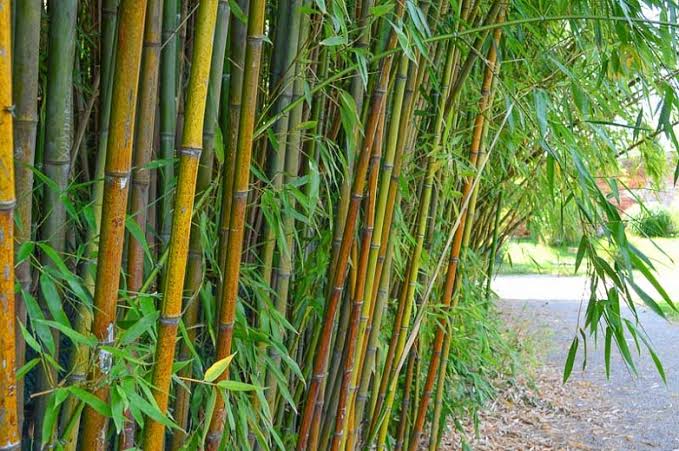
Phyllostachys Viridiglaucescens, also known as Green Glaucous Bamboo, is a vigorous, evergreen bamboo variety. Grown for its attractive, tall canes and lush green foliage, this cultivar is an ideal candidate for evergreen screening or hedging. One of the main reasons why this variety of bamboo is so popular is that it offers year-round interest.
The glossy, green canes mature to yellowish-green, and the profusion of bright green foliage remains on the tall, erect canes throughout the seasons. The lanceolate leaves are brilliant green with a glaucous (greyish-blue) underside, hence the name Green Glaucous Bamboo. Each leaf can be up to 15 centimeters long.
12. Marbled Bamboo
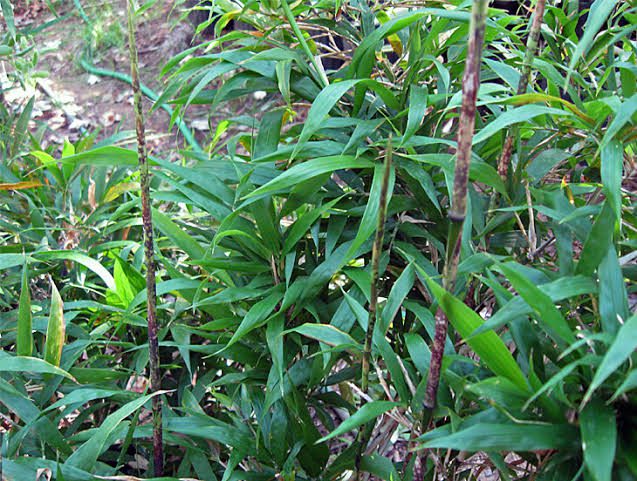
The Chimonobambusa Marmorea, commonly called the Marbled Bamboo, is a semi-dwarf evergreen ornamental grass plant that rarely exceeds 2.5 meters in height with a spread of about 3 meters. The leaves are small when compared to larger varieties of bamboo. Each leaflet is lance-shaped. The petite size of the foliage gives the plant a feathery appearance and makes it look more bush-like than typically classic golden bamboo or black bamboo.
Marbled Bamboo produces eye-catching culms that are a mottled white and brown shade upon maturation. Young shoots first appear in hues of vibrant mint green. When fully grown, the culms generally measure 13 to 15 mm in diameter. The diminutive size of the marbled bamboo plant makes it an ideal bamboo variety for container growth. It also grows well as a houseplant and is believed to bring good fortune to the home’s inhabitants.
The marbled bamboo plant spreads by rhizomes, but it produces relatively shallow roots so is easily maintained. The plant can be simply pulled or dug up in unwanted areas of the garden. It tolerates transplanting well so can be relocated to other new areas of the garden. The bush-like growth of the marble bamboo makes it an ideal low growing hedge plant for privacy. It grows well in full shade, partial shade, or full sun with adequate water.
Also Read: Types of Locust Trees
13. Golden Bamboo/Fish Pole Bamboo

Phyllostachys Aurea or Golden Bamboo is one of the best large, clump forming variety of bushy Bamboo. It is an excellent plant for a tall privacy screen. Golden Bamboo produces luscious green canes which as its name suggests become more golden yellow as the plant gets more mature.
Phyllostachys Aurea is also sometimes commonly referred to as Fishpole Bamboo and will only achieve its full height and spread in the more sheltered settings. The Bamboo is extremely popular in American and British gardens and is often used as an evergreen screening plant. This bamboo variety works well when planted as a bamboo hedge, offering a tropical feel to the garden design whilst successfully screening off any undesirable areas.
14. Yellow Groove Bamboo

Yellow Groove Bamboo or Phyllostachys Aureosulcata is a bamboo native to China – it is extremely hardy, evergreen plant that is particularly useful for screening and hedging purposes. This densely bushy bamboo plant has lemon yellow canes which become more of an orange color when exposed to sunlight. Phyllostachys Aureosulcata prefers full sun but can be grown in partial shade and for this reason it’s a useful plant for screening off shaded areas or for interest in the darker recesses of the garden.
15. Pingwu (Fargesia Robusta Pingwu)

The Fargesia Robusta Pingwu is a clumping bamboo with variegated, checkered culms that is non-invasive and ideal for creating a narrow screen because of its tight growth habits. When fully grown, it reaches a height of about 5 meters. Generally, it takes about five years for the bamboo to reach its full potential.
The culms of the Fargesia Pingwu are exceptionally attractive. The new shoots emerge in the early spring months and are rusty red in colour. The young shoots are covered with fine noticeable hairs. As they mature, the culm starts to turn a light, bright green and sheds the fine hairs.
During the early summer months, the leaves start to peel away from the middle of the culms and the remaining leaf sheaths fade to white which creates a checkerboard appearance up and down the length of the culm. The variegated appearance of the culms persists from spring into late summer.
In Autumn, the top of the culm starts to produce branches and additional leaves. The bottom half of the culms remain bare throughout the winter months.
Also Read: Varieties of Arbovitae Trees
16. Campbell Bamboo
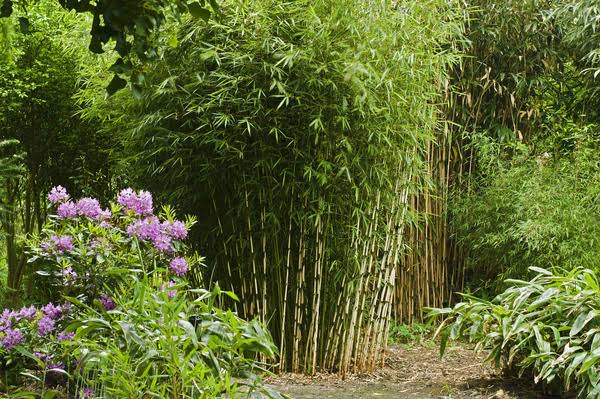
Fargesia Robusta Campbell is an attractive, evergreen upright and strong-growing bamboo, ideal for evergreen screen, hedging and creating privacy in difficult situations. Fargesia Robusta Campbell (or Campbell Bamboo) is able to reach heights of 4.5 meters and widths of only 1.5 meters, making it an ideal solution for situations where privacy is required but not much lateral space is available.
Fargesia Robusta Campbell is a large, fast-growing, robust bamboo from China with strong, green canes and bright green leaves. The attractive dark green canes tend to be narrow and slim featuring white sheaths creating an alternate green and white color effect on the slender canes. The Campbell variety of the robust bamboo is particularly upright and therefore ideal for screening. Fargesia Robusta Campbell forms a dense column and, importantly for many gardeners, is non-invasive. Plant this bamboo in a sunny spot ideally but it will also grow in some shade.
17. Painted Bamboo
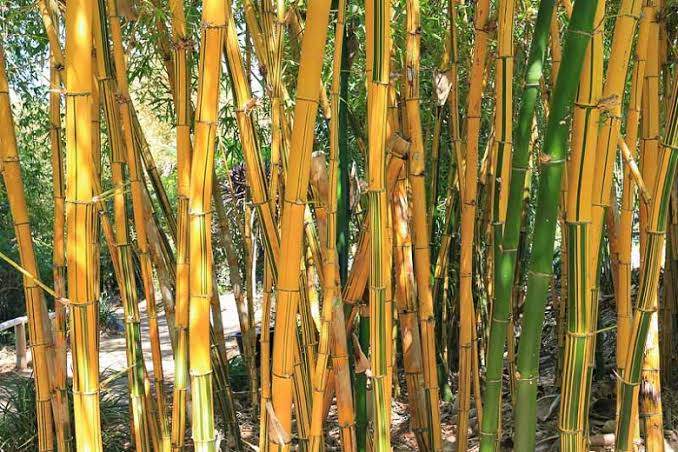
Bambusa vulgaris ‘Vittata’ or Painted Bamboo, (previously known as Bambusa striata) is a giant tropical and subtropical clumping bamboo native to China and Japan. It is one of the most cultivated ornamental bamboos in the tropical world.
The glossy culms of Bambusa vulgaris ‘Vittata’ are bright yellow randomly marked with narrow and broad green stripes (or rarely light green with yellow stripes), and have an average height between 10-15 m. Internodes are 10-15 cm long, thick-walled, and have an average diameter of 5-8 cm.
Also Read: Types of Maple Trees
18. Chilean Bamboo

Chusquea Culeou or Chilean Bamboo is a hardy, evergreen variety which is notable for its branching habit, giving it a bushy appearance this is a clumping, non-invasive bamboo and native to the southern South America.
Chilean Bamboo is a temperate zone bamboo which is very well-suited to UK gardens. When the canes first emerge they are smooth, glossy, and leafless, with a striped appearance, growing to a diameter of 3 cm. Within a year the canes will mature to an olive green and develop an abundance of branches 10-80 cm long with medium green leaves as long as 6 cm. The foliage is evergreen, providing a dense screen year-round.
This bamboo variety is hardy and will grow to a mature height of 4-8 meters and spread of 1.5-2.5 meters in 5 to 10 years. Plant this bamboo 1.8 meters apart for a hedge screen. Thin out dead or damaged canes in spring, and cut out flowering stems as they develop.
19. Timber Bamboo
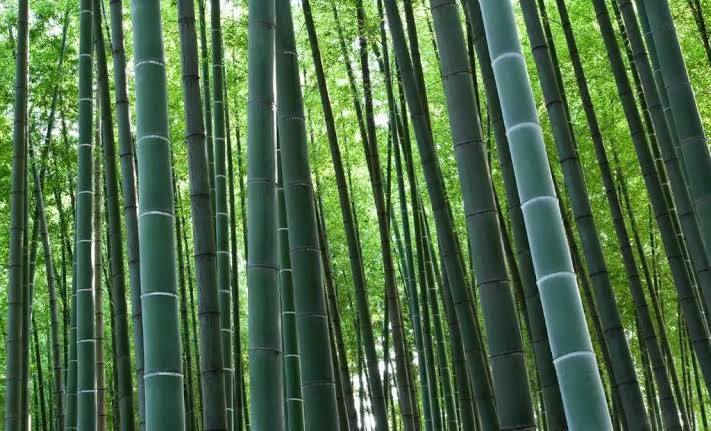
Bambusa oldhamii, known as giant timber bamboo or Oldham’s bamboo, is a large species of bamboo. It is the most common and widely grown bamboo in the United States and has been introduced into cultivation around the world. It is densely foliated, growing up to 20 meters (65 feet) tall in good conditions, and can have a diameter of up to 10 centimeters (4 inches).
Also Read: Types of Snake Plant
20. Mexican Weeping Bamboo

The Mexican weeping bamboo, Otatea acuminata, is a clumping bamboo native to central and southern Mexico and Central America. The plant produces thick stands of culms with long narrow leaves. The weight of the leaves cause the long thin culms to bend, or weep. The clump’s vegetation can reach 25 feet (7.6 m) or more in height and width in its native habitat.
Mexican Weeping Bamboo and its cultivars are cultivated as an ornamental plant, often planted in subtropical and temperate climate gardens in full or partial sun. The plant is drought tolerant when established, but benefits from periodic watering and feeding. Mexican Weeping Bamboo is easily grown in pots, reaching around 6 feet (1.8 m) tall. When planted in the ground it can reach 15 feet (4.6 m) or more with regular water.
Bamboo Care
All bamboos require well-draining, loose and slightly acidic soil. The ideal pH is between 5.5 and 7.0. The ideal location receives at least five hours of sunlight daily and is large enough to accommodate the number of plants desired with a spacing about 3 to 5 feet apart. The plants need about 1 inch of water per week. You can fertilize outdoor bamboo using organic fertilizer, such as horse manure or fish meal. Indoor bamboo plants do well with 21-5-6 formulation fertilizers, following package directions.
How to Grow Bamboo from Culm Cuttings
- Fill nursery containers with a mix of equal measures sterile potting soil, perlite and coarse sand. Pour water onto the mixture to settle it. Keep adding water until it feels very moist throughout.
- Gather a 4- to 6-inch-long cutting from the base of a healthy bamboo culm. Make sure the culm has a diameter of 1/2- to 1-inch. Sever the culm at soil level using sturdy bypass shears or a lightweight saw. Gather culm, or stem, cuttings in the morning when the bamboo plant is hydrated and the weather is cool.
- Trim the base of the culm so the severed end is 1/8 inch below a leaf node. Trim the top of the cutting 1 inch above a leaf node. Cut off any extra branches and one-half of the leaves.
- Bury the bottom half of the bamboo cutting in the prepared rooting container. Position the cutting at a 20-degree angle with the leafy end exposed and the base completely covered.
- Water the bamboo cutting thoroughly and place it inside an unventilated cold frame. Warm the pot with a heating coil set to 75 F. Provide light shade in the afternoon.
- Probe the potting soil mixture with your finger every day to test the moisture level. Add water when it feels completely dry just below the surface. Avoid over-watering to prevent rot.
- Watch for signs of new growth in six weeks. Continue to grow the bamboo cutting in the cold frame until after the last frost, then move it to a permanent planting site with fast-draining soil and full sun.
- Acclimate the bamboo to conditions at the planting site for one week to prevent stress. Transplant it into the bed. Keep it well-watered for the first summer, then cease all supplemental irrigation during the rainy season.
How to Grow Bamboo From Rhizome Cuttings
- Water the bamboo plant deeply the day before gathering rhizome cuttings. Run a hose at the base of the plant for approximately five minutes, or until the soil feels very moist in the top 5 inches.
- Measure out a 6-inch-square portion of stems at the outer edge of the bamboo plant. Cut off the culms, or stalks, just above a pair of leaves using sturdy bypass shears.
- Insert the blade of a pointed shovel into the soil between the trimmed portion of the plant and the main clump. Work the shovel blade back and forth to sever the connecting roots.
- Dig a 5-inch-deep trench along the outer edge of the bamboo plant. Press the shovel blade underneath the trimmed portion fo the plant at a 45-degree angle. Pry it loose from the soil.
- Rinse off the soil that clings to the rhizomes. Cut the rhizomes into portions with two or three growth buds on each with a gardening knife. Discard any rhizomes with a dark, spotty appearance because they will lack vigor.
- Pot the rhizome cuttings in individual plastic nursery pots. Lay them horizontally with the growth buds facing up. Cover them with a 3-inch-thick layer of soil and water until the soil feels wet in the top 5 inches.
- Place the nursery container in a cold frame under light shade. Warm the pots with a heating coil set to 75 degrees Fahrenheit. Water whenever the soil feels barely moist in the top 3 inches. Avoid over-watering the rhizome cuttings because they will rot.
- Watch for renewed growth in four to six weeks. Grow the bamboo in the cold frame until late spring when nighttime temperatures stay reliably above 55 F. Harden off the plants for one week, then transplant them into a permanent bed.
Growing Bamboo for Privacy
Planting a Privacy Screen
In the Mediterranean climate throughout the region, you can plant bamboo any time of year but late fall; winter or early spring during the rains is ideal. When planting during the dry season, bamboo requires frequent watering until established. The best way to plant a privacy screen around a patio, or along a border area or fence line is to start with a trench the same depth as the root ball. A spacing of 3 to 5 feet between plants will result in a dense privacy hedge. After planting, a mulch layer over the roots will improve moisture levels in the soil and regulate temperature. A large, clumping bamboo outside a window creates a visual privacy screen that doesn’t block too much light.
Container Grown Bamboo for Privacy
For a movable privacy screen or accent, grow bamboo in patio pots. Potted bamboo can be used to create a privacy screen along a patio, driveway or property line. Once filled with soil and a mature bamboo plant, they are not going to be terribly easy to move, but you still can drag them around with a hand truck. Clumping bamboo is better suited for containers than running bamboo. A full grown clump of bamboo can be top heavy, so look for wide shallow pots with a broad base for container-grown bamboo plants.
Further References
- Bamboo Facts: https://en.m.wikipedia.org/wiki/Bamboo
- Information About Bamboo: https://www.britannica.com/plant/bamboo
- Bamboo Farming: https://www.standardmedia.co.ke/farmkenya/amp/article/2001353114/bamboo-farming-has-good-returns-on-investment
- Types of Bamboo: https://www.bhg.com.au/10-different-types-of-bamboo
- Bamboo Varieties: https://www.conserve-energy-future.com/types-of-bamboo.php
- List of Bamboo Varieties: https://en.m.wikipedia.org/wiki/List_of_bamboo_species